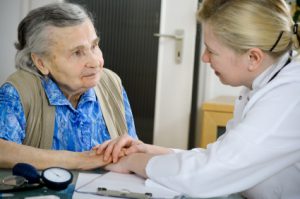 Elderly malnutrition takes place when an elderly person is either not getting enough food or is not getting enough of the right sorts of food. If food does not contain enough vitamins and minerals to meet the recommended daily value for elderly people, malnutrition may come as a result. In nursing homes, malnutrition is a serious and wide-spread problem.
Elderly malnutrition takes place when an elderly person is either not getting enough food or is not getting enough of the right sorts of food. If food does not contain enough vitamins and minerals to meet the recommended daily value for elderly people, malnutrition may come as a result. In nursing homes, malnutrition is a serious and wide-spread problem.
Elder Malnutrition in Nursing Homes
In addition to dehydration, elderly malnutrition represents the most wide-spread health issue present at nursing homes. There are around 1.6 million nursing home residents in the US, and it is estimated that up to a third of these individuals suffer from elderly malnutrition or dehydration. In some nursing homes, the rate of elderly malnutrition is as high as 85 percent. Additionally, between 30 and 50 percent of a nursing home’s elderly population may be underweight, potentially as a result of malnutrition.
A number of common ailments come about as a result of elderly malnutrition. In the absence of malnutrition, many of these ailments would be easily avoidable. Elderly malnutrition is preventable. The presence of elderly malnutrition in the nursing home setting is often a sign of potential mismanagement or neglect by nursing home staff.
Causes of Elder Malnutrition
Many of the causes of elderly malnutrition can be traced back to the conduct of nursing home staff. In a large number of nursing home settings, a single certified nursing assistant may be responsible for ensuring that up to nine residents receive adequate nutrition over the course of their day. During evening mealtimes, a single certified nursing assistant may be responsible for the nutrition of up to 15 residents. However, studies show that a certified nursing assistant should ideally only be responsible for the nutrition of two to three residents.
In addition to understaffing, nursing home staff inexperience may lead to elderly malnutrition. The field of certified nursing assistants experiences a 93 percent turnover rate each year. This excessive staff turnover rate can contribute to staff members making errors or lacking proper training.
Elder Malnutrition Symptoms
Elderly malnutrition can lead to a range of serious complications. Certain symptoms often accompany the onset of malnutrition and manifest themselves physically. Keeping an eye on the physical appearance of a loved one may be helpful in identifying elderly malnutrition.
Physical symptoms of elderly malnutrition may include:
– Mouth Signs: In the presence of elderly malnutrition, a sufferer’s mouth may become a bright shade of red. Canker sores may be present. Additionally, thrush or a yeast infection can cause white patches to develop on the cheeks and tongue.
– Muscular Problems: Elderly malnutrition can cause muscles to become flaccid. This is a result of the body using up nutrients stored in the muscle tissue in order to make up for a lack of incoming nourishment. Simple tasks may bring on fatigue.
– Eye Signs: Red, glassy eyes or swollen corneas may also be symptoms of elderly malnutrition. Vision may worsen as well.
– Cognitive Difficulties: Lack of proper nourishment will eventually affect a loved one’s ability to think clearly. They may appear listless or irritable. In advanced cases of elderly malnutrition, dementia and confusion present themselves.
– Skin Issues: The skin may take on a yellowish color as a result of elderly malnutrition. The skin of darker-complexion individuals may appear dull. Additionally, skin may become heavily wrinkled, and the skin beneath fingernails can turn white.
Elder Malnutrition Lawsuits
It is possible for elderly malnutrition to result from improper conduct by nursing home staff. Negligence and abuse can often result in nursing home residents not receiving an adequate amount of food. If a nursing home fails to provide a loved one with proper care, a lawsuit can help to compensate the nursing home resident and their family.
Sources:
Hickson, M. “Malnutrition and ageing.” Postgraduate Medical Journal. (2006): n. page. Print. http://www.ncbi.nlm.nih.gov/pmc/articles/PMC2563720/
Mahon, Mary. “Malnutrition And Dehydration Plague Nursing Home Residents.” Commonwealth Fund. The Commonwealth Fund, 7 6 2000. Web. 16 May 2013. http://www.commonwealthfund.org/News/News-Releases/2000/Jun/Malnutrition-And-Dehydration-Plague-Nursing-Home-Residents.aspx
Staff, Mayo Clinic. “Senior health: How to prevent and detect malnutrition.” Mayo Clinic. Mayo Clinic, 23 9 2011. Web. 16 May 2013. http://www.mayoclinic.com/health/senior-health/HA00066/NSECTIONGROUP=2
